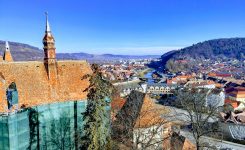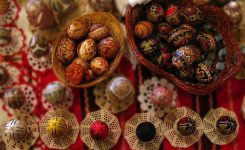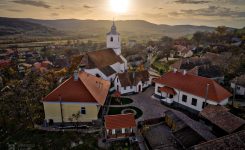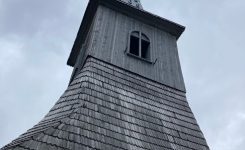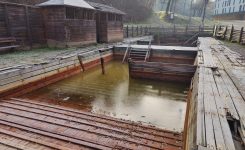Tourism
The funeral of carnival
gathering in the town centre
In some regions, the date of Farsangtemetés is tied to the lunar calendar and may fall on different days on each year. However, the “Farsangtemetés” event we attended was intentionally scheduled for February 22nd to coincide with the Christian observance of Ash Wednesday, which marks the start of lent. During lent (which is a 40-day fasting period before Easter) many Christians abstain from meat, dairy and other indulgences as a form of penance and spiritual discipline. “Farsangtemetés” serves as the last day of the “farsang” season which is often associated with feasting, drinking, and merrymaking and may be observed as a way to indulge and celebrate before the start of this more solemn period.
the so called Illyés figure
One of the central features of “Farsangtemetés” is the funeral procession or parade featuring an effigy made of hay. The effigy represents the spirit of “Farsang”, it is a fully clothed humanlike figure, called Illyés with a male genitalia made of a carrot and two potatoes.
the so called Illyés figure
One of the central features of “Farsangtemetés” is the funeral procession or parade featuring an effigy made of hay. The effigy represents the spirit of “Farsang”, it is a fully clothed humanlike figure, called Illyés with a male genitalia made of a carrot and two potatoes.
the so called illyés figure
One of the central features of “Farsangtemetés” is the funeral procession or parade featuring an effigy made of hay. The effigy represents the spirit of “Farsang”, it is a fully clothed humanlike figure, called Illyés with a male genitalia made of a carrot and two potatoes.
This effigy is carried through the village with the whole procession, which consists of the main leader/speaker, who is a parody of a preacher, the carriers of the figurine, then a group of women and even some men all dressed up in women’s clothes. They act like mourners or lamenters,loudly expressing their sadness over the death of Ilyés, the rest of the procession is just general audience who don't serve any specific purpose, followed last by the musicians who are playing traditional folk music.
At each stop the main speaker holds a speech which is one of the lamentation’s destined for Illyés and is also made in a humorous way. These songs or performances often mock some Christian elements. Thereafter the whole procession starts dancing to the music surrounding the effigy which is placed on the ground. They perform a traditional dance, called “csárdás”, which is a couple dance and we had the opportunity to try it out.
personal thoughts
Jaanus: “I thought it was a great and fun event, it was nice to see so many celebrating people out on the streets. I must admit, I don’t know of any similar events in Estonia. Mostly we just celebrate the summer solstice by making huge bonfires on the evening of the 23rd of June. However, hardly ever is someone serving free food and drinks to the masses. I also enjoyed the live music and I felt that the whole atmosphere was one merriment, just a nice bunch of people enjoying themselves on the streets.” Timotej: “It was an interesting event to experience, because it is a unique local tradition. It was nice to gain a little bit of insight into the lives of the locals, their perspectives and how do they deal with their difficulties through the use of humor and parody. It's nice to see the resilience of the people to keep the traditions of the old alive.” Quentin: “I enjoyed witnessing this event, I don’t think I’ve ever participated anything like that before, so it was interesting to discover something new. It was interesting to discover this part of the Szekler culture. I hope this tradition keeps on going through the years, I think it would be a big loss if it dies out.”


